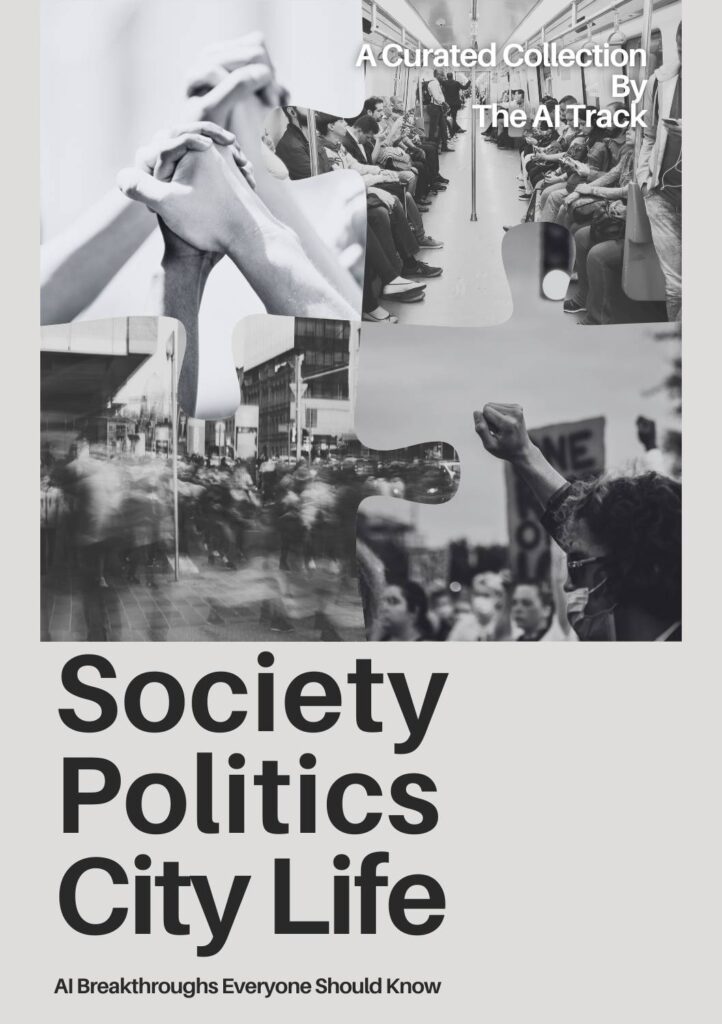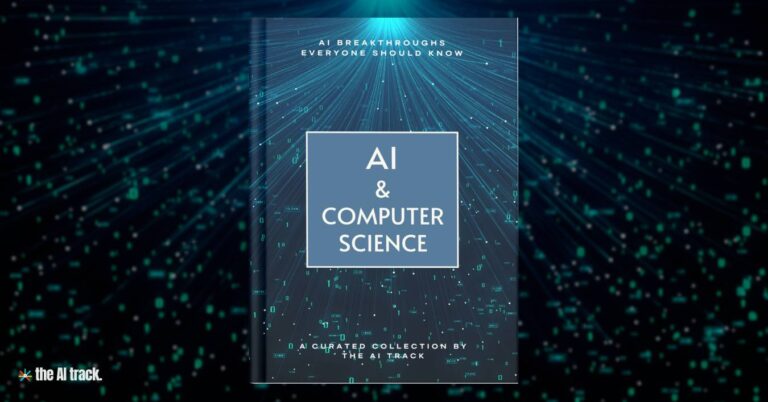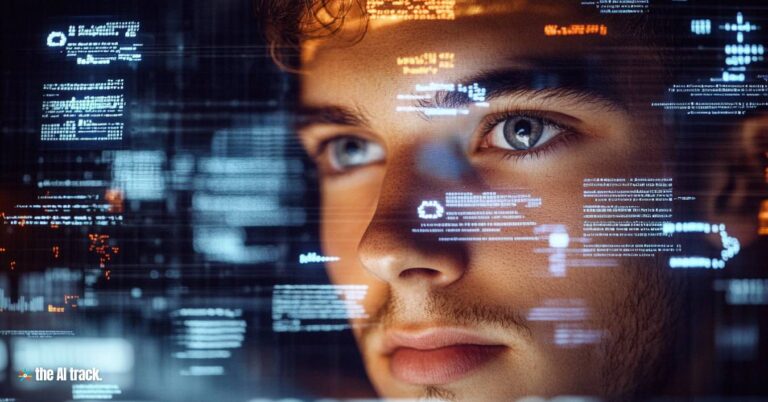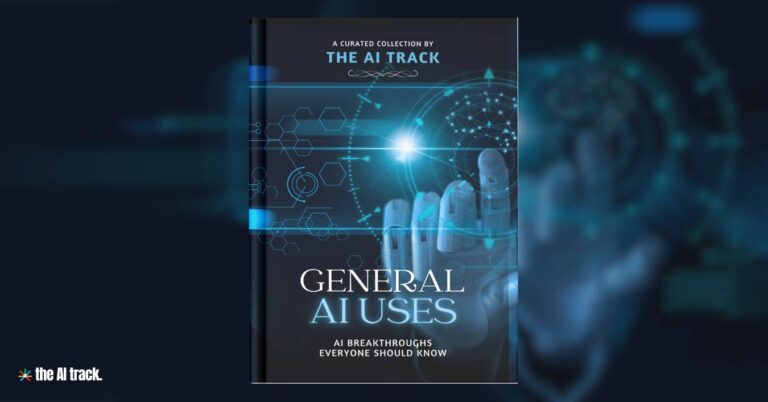
From governance to urban planning, AI is reshaping the fabric of society. This page showcases the pivotal AI breakthroughs in society that are influencing politics, city life, and social structures.
Browse all the other fields in our curated collection of the most important AI Breakthroughs. Each section offers insights into how AI is transforming different sectors, providing a comprehensive view of its impact across a wide range of disciplines.
AI Breakthroughs in Computer Science - At a Glance
The Transformative Power Of AI In Politics: Reshaping Campaigns, Governance, And Democracy

The AI Track’s extensive analysis of the impact of AI in politics, revealing its transformative impact on elections, campaigns, and governance. Our analysis underscores the dual nature of AI as a tool for advancing democratic engagement and policy-making, while also posing risks like the spread of disinformation
LA's new AI pilot aims to predict & prevent homelessness by identifying high-risk residents
Original Article Title:
Los Angeles is using AI in a pilot program to try to predict homelessness and allocate aid
Source: CNBC
Date:
Los Angeles is pioneering an AI-driven pilot program aimed at predicting and preventing homelessness. The program uses a predictive algorithm developed by the California Policy Lab at UCLA to identify residents at high risk of becoming homeless. This AI tool analyzes data on individuals’ interactions with various social services and predicts the likelihood of homelessness, enabling proactive intervention.
The AI model has been trained using historical data to enhance its predictive accuracy. For example, it was fed data about people who eventually became homeless and the services they accessed prior to losing their housing. The algorithm was then used to predict who among a new group might face similar risks. The results showed that targeting the highest-risk individuals led to a more efficient allocation of resources, as these individuals were significantly more likely to benefit from the assistance offered.
Participants in this program receive financial aid ranging from $4,000 to $6,000 to cover essential expenses like rent and utilities, which is critical in preventing their slide into homelessness. Social workers reach out directly to these individuals, often having to overcome initial skepticism to get them enrolled in the program. This direct intervention model, powered by AI, represents a significant shift towards more data-driven, targeted social welfare programs that aim to prevent homelessness before it occurs.
This approach has sparked interest in potentially replicating similar AI-driven preventative measures in other regions, driven by its early successes in addressing and mitigating the complex issue of homelessness in Los Angeles.
Facial Recognition Technology and Human Raters Can Predict Political Orientation From Images of Expressionless Faces Even When Controlling for Demographics and Self-Presentation
Original Article Title:
Facial Recognition Technology and Human Raters Can Predict Political Orientation From Images of Expressionless Faces Even When Controlling for Demographics and Self-Presentation
Source: American Psychologist
Date: June 1, 2024
Key Takeaway:
Political orientation can be predicted from neutral facial images by both humans and facial recognition algorithms, even when controlling for factors like age, gender, and ethnicity.
Key Points:
- The study involved 591 participants whose carefully standardized facial images were presented to human raters and a facial recognition algorithm.
- Both humans (r = .21) and algorithms (r = .22) accurately predict political orientation from facial images.
- The algorithm’s accuracy increased (r = .31) when it also considered age, gender, and ethnicity.
- Predictive models from standardized images can predict political orientation from naturalistic images of politicians with an accuracy of r ≈ .13.
- Analysis of facial features showed conservatives tend to have larger lower faces.
- The predictive model generalized beyond the study sample, successfully predicting political orientation from naturalistic images of 3,401 politicians.
- The findings highlight significant privacy implications and the need for regulating facial recognition technology.
Why This Matters:
These findings have critical implications for privacy, suggesting that facial recognition technology can infer sensitive personal traits beyond an individual’s control. This raises concerns about privacy and the potential misuse of facial recognition technology, emphasizing the need for greater regulation and awareness of the risks associated with this technology.
The U.S. employed AI, specifically the "Raven Sentry" program, to predict Taliban attacks during the troop drawdown in Afghanistan
Original Article Title:
How the US used AI to take on the Taliban amid drawdown
Source: Fox News
Date: August 4, 2024
Key Takeaway: The U.S. employed AI, specifically the “Raven Sentry” program, to predict Taliban attacks during the troop drawdown in Afghanistan, achieving a 70% success rate in forecasting potential threats.
Key Points:
- AI Utilization: Launched in 2019, Raven Sentry used machine learning to analyze diverse data, including weather patterns and activity around mosques.
- Operational Impact: The AI system significantly enhanced the ability to predict attacks, aiding in strategic planning and response.
- Challenges and Success: Initial development faced hurdles, but advances in technology and a tolerance for early failures led to operational success.
Why This Matters: AI’s predictive capabilities improve military intelligence, ensuring better preparedness and security in conflict zones.
Brazil hires OpenAI to cut costs of court battles
Original Article Title:
Brazil Hires OpenAI to Cut Costs in Court Battles
Source: Reuters
Date: 11 June 2024
Key Takeaway: Brazil is employing OpenAI’s AI technology to analyze lawsuits and potentially reduce the growing burden of court-ordered debt payments.
Key Points:
- The AI service will alert the government about lawsuits before final decisions, enabling proactive action.
- Microsoft will provide OpenAI’s AI services through its Azure platform.
- The cost of these services has not been disclosed.
- In 2024, the Brazilian government expects to spend 70.7 billion reais on judicial decisions that can’t be appealed.
- Including small-value claims, the total court-related spending is estimated to exceed 100 billion reais.
- This amount represents a significant increase from 37.3 billion reais in 2015.
- The reason for the rising court costs was not specified by the AGU.
- The AI project aims to improve efficiency and accuracy, but it won’t replace human workers.
- The Planning Ministry allocated 25 million reais for strategic IT projects, including this AI initiative.
Why This Matters: This move could significantly impact Brazil’s fiscal health by reducing the financial burden of court-ordered payments. It also highlights the growing adoption of AI in government operations for improved efficiency and decision-making.
The Impact of AI in Work: Challenges, and Opportunities

The AI Track’s extensive analysis explores how AI is reshaping jobs and workplaces, emphasizing the need for human-AI collaboration and upskilling in the AI-driven workforce.
Argentina will use AI to ‘predict future crimes’ but experts worry for citizens’ rights
Original Article Title:
Argentina will use AI to ‘predict future crimes’ but experts worry for citizens’ rights
Source: The Guardian
Date: 1 August 2024
Key Takeaway: Argentina’s government plans to use artificial intelligence (AI) to predict and prevent future crimes. This initiative aims to enhance security measures but raises significant concerns about potential infringements on citizen rights and freedoms.
Key Points:
- AI Initiative: The Ministry of Security in Argentina has announced the creation of an Artificial Intelligence Unit Applied to Security (UIAAS). This unit will use machine learning algorithms to analyze historical crime data and predict future crimes.
- Technological Measures: The AI system will incorporate drone surveillance, social media monitoring, and facial recognition to bolster security efforts.
- Government Justification: The government argues that this technology will improve the efficiency of security forces, allowing for faster and more precise responses to threats and emergencies.
- Human Rights Concerns: Human rights groups are worried that these measures could infringe on freedom of expression and lead to self-censorship. There are concerns about the lack of transparency and accountability in the use of such technologies.
- Historical Context: The use of facial recognition by the government was previously ruled unconstitutional by a Buenos Aires court in 2023 due to non-compliance with legal requirements for protecting personal rights.
- Global Context: The initiative is inspired by similar uses of AI in countries like the United States, China, and Israel, which have integrated AI into their security operations.
Why This Matters: The implementation of AI to predict and prevent crimes represents a significant shift in law enforcement practices. While it promises enhanced security and efficiency, it also poses serious risks to civil liberties and privacy. Ensuring transparency and accountability in the deployment of such technologies is crucial to prevent potential abuses and protect citizen rights.
Artificial intelligence is helping to identify global inequalities
Original Article Title:
Artificial intelligence is helping to identify global inequalities
Source: Nature
Date: May 27, 2024
Key Takeaway:
AI is playing a crucial role in identifying and addressing global inequalities by helping researchers understand income distribution and societal divisions. These insights are essential for developing effective policies aimed at reducing inequality within and among countries, as outlined in the UN’s Sustainable Development Goal 10.
Key Points:
- Machine learning tools help identify key predictors of inequality.
- AI aids in understanding income distribution and societal divisions.
- The goal is to ensure sustained income growth for the bottom 40% of the population.
- Researchers emphasize the importance of tackling inequality to improve overall societal well-being and economic performance.
- Highlighting inherited inequalities can drive political support for redistributive policies.
Amazon-Powered AI Cameras Used to Detect Emotions of Unwitting UK Train Passengers
Original Article Title:
Artificial intelligence is helping to identify global inequalities
Source: WIRED
Date: 17 June 2024
Key Takeaway: Amazon is testing AI-powered cameras in UK trains to monitor and analyze passengers’ emotions to enhance safety and customer service.
Key Points:
- Technology Usage: AI cameras can detect emotions such as stress, anger, or anxiety.
- Safety Measures: The data helps train staff respond to potential safety issues proactively.
- Privacy Concerns: This surveillance raises significant ethical questions regarding privacy and the implications of monitoring public behavior.
Why This Matters: This technology could reshape public safety and customer service while igniting debates on privacy and surveillance ethics.
Binit, a startup, is using AI to revolutionize waste management
Original Article Title:
Binit is bringing AI to trash
Source: TechCrunch
Date: 3 June 2024
Key Takeaway: Binit, a startup, is using AI to revolutionize waste management by improving recycling processes and reducing waste contamination.
Key Points:
- AI Integration: Binit’s AI technology automates waste sorting, increasing recycling efficiency.
- Environmental Impact: The system aims to reduce landfill waste and enhance sustainability.
- Scalability: Binit is targeting expansion, aiming to bring its AI-driven solutions to more cities and industries.
Why This Matters: Binit’s AI-driven approach could significantly advance global recycling efforts, promoting environmental sustainability.
AI in Military: How AI is Changing the Game of War Forever

The AI Track’s extensive analysis explores how militaries worldwide are aggressively adopting artificial intelligence across diverse functions to gain strategic advantages.
A Dubai chef created a smash-hit pizza using a recipe generated by ChatGPT
Original Article Title:
Chef Admits His Smash Hit Pizza Was Invented by ChatGPT
Source: Futurism
Date: 31 August 2024
A Dubai chef created a smash-hit pizza using a recipe generated by ChatGPT, surprising customers and himself with an unconventional but successful mix of flavors.
Key Points:
- Innovative Recipe: ChatGPT suggested a pizza recipe featuring Arab shawarma chicken, Indian grilled paneer, Middle Eastern Za’atar, and tahini sauce, which became a hit at Dodo Pizza in Dubai.
- Unexpected Success: Despite the unusual combination, the pizza sold exceptionally well and remains on the menu.
- Rejected Ideas: Other AI-generated recipes, such as pizza with strawberries and pasta, were not as successful.
Police officers are starting to use AI chatbots to write crime reports.
Original Article Title:
Police officers are starting to use AI chatbots to write crime reports. Will they hold up in court?
Source: NBC News
Date: 26 August 2024
Police departments across the U.S. are beginning to use AI chatbots to draft crime reports, significantly reducing the time officers spend on paperwork. While this technology, built on the same model as ChatGPT, offers time-saving benefits and potential improvements in report accuracy, it also raises concerns about the reliability of AI-generated reports and the broader implications for the criminal justice system.
Key Points:
- AI-Generated Reports: The Oklahoma City Police Department, among others, is experimenting with an AI tool called “Draft One” to create first drafts of incident reports based on audio captured by body cameras. The AI generates these reports in seconds, which officers describe as being more accurate and better flowing than their own written reports.
- Benefits for Police Work: Officers like Sgt. Matt Gilmore from Oklahoma City have found the AI-generated reports to be a game-changer, significantly reducing the time spent on data entry. Axon, the company behind Draft One and known for its Tasers and body cameras, claims this tool has received the most positive reaction of any product they’ve introduced.
- Concerns and Cautions: Despite the enthusiasm, there are concerns about the potential downsides of AI-generated reports. Legal scholars, like Andrew Ferguson, worry that the ease of automation could lead officers to be less careful in their report writing, which could introduce subtle inaccuracies or “hallucinations”—false information generated by AI—into crucial documents that play a significant role in legal proceedings.
- Limited Use in High-Stakes Cases: Currently, the Oklahoma City Police Department is using Draft One only for minor incident reports that do not lead to arrests or involve violent crimes. However, other departments, like those in Lafayette, Indiana, and Fort Collins, Colorado, allow broader use of the tool across various types of cases.
- Broader Implications: The introduction of AI-generated police reports has sparked debate about the potential for racial biases to be embedded in AI technology and the broader impact on civil rights. Community activists express concern that such tools could exacerbate issues of police surveillance and harassment, particularly in communities of color.
- Technology and Future Use: Axon, working with OpenAI and Microsoft, has designed the AI to stick closely to facts by adjusting its “creativity dial” to avoid embellishments. While the technology is still new, it is expected to become more widespread as more departments adopt AI-driven tools for report writing.
Why This Matters: The integration of AI into police work, particularly in drafting crime reports, represents a significant shift in how law enforcement agencies operate. While the technology offers clear benefits in efficiency and accuracy, it also introduces new risks, particularly concerning the potential for AI to introduce inaccuracies or biases into critical legal documents. As AI-generated reports become more common, it will be essential to establish clear guidelines and safeguards to ensure their reliability and fairness in the justice system.
AI Cameras in UK Catch Seat Belt and mobile phone Offenses
Original Article Title:
Devon and Cornwall AI Cameras Spot Toddlers Not Wearing Seat Belts
Source: BBC
Date: 31 August 2024
Key Takeaway:
AI cameras in Devon and Cornwall (UK) have detected over 2,000 seat belt (with more than 100 involving children), and over 800 mobile phone offenses in a short period. Authorities are alarmed and suggest adding penalty points to fines for seat belt violations, especially given the potential dangers to young passengers.
Key Points:
- AI Camera Detection: Between 25 July and 17 August 2024, AI cameras on three major roads (A388, A361, A38) in Devon and Cornwall detected 2,239 seat belt violations, including 109 children not properly restrained.
- Case of Unrestrained Toddler: One particularly shocking case involved a toddler sitting on a woman’s lap in the front passenger seat, highlighting severe risks in the event of a crash or sudden stop.
- Call for Tougher Penalties: Adrian Leisk, head of road safety for Devon and Cornwall Police, is pushing for seat belt violations to not only carry fines (up to £500) but also attract penalty points to deter offenses.
- Impact of Non-Compliance: Seth Marks, a young man who was left paralyzed in a crash for not wearing a seat belt at 18, shared his story, urging others not to make the same mistake, emphasizing the lifelong consequences.
- AI Camera Technology: The AI cameras, developed by Acusensus, use high shutter speeds, infra-red flash, and filtering systems to capture clear images of vehicles. Offenses are detected by AI and reviewed by human experts.
- Mobile Phone Offenses: Alongside seat belt violations, over 800 mobile phone offenses were captured in the same period, showing the broader issue of unsafe driving behavior.
- Police Safeguarding Action: Authorities are conducting welfare visits to the guardians of the children involved, ensuring their safety and preventing future risks.
- Public Reaction and Charity Support: Road safety advocates, such as the charity Brake, are deeply concerned about the disregard for seat belt laws, particularly when children’s lives are at risk.
- Costs of the AI Program: The 12-month project, funded by road offense fines, is costing “hundreds of thousands” of pounds, with future plans to deploy the cameras in other regions like Plymouth and Torbay.
Why This Matters:
This AI camera initiative reveals the extent of seat belt non-compliance, particularly among children, and highlights the need for stronger enforcement and penalties. The data underscores the potential life-threatening consequences of such behavior, with authorities and advocates calling for immediate action to protect vulnerable road users. The success of similar systems in Australia suggests this technology can significantly change driver behavior over time.
How artificial intelligence is helping to identify global inequalities
Original Article Title:
How artificial intelligence is helping to identify global inequalities
Source: Nature
Date: 27 May 2024
Key Takeaway:
AI is playing a crucial role in identifying and addressing global inequalities by helping researchers understand income distribution and societal divisions. These insights are essential for developing effective policies aimed at reducing inequality within and among countries, as outlined in the UN’s Sustainable Development Goal 10.
Key Points:
- Machine learning tools help identify key predictors of inequality.
- AI aids in understanding income distribution and societal divisions.
- The goal is to ensure sustained income growth for the bottom 40% of the population.
- Researchers emphasize the importance of tackling inequality to improve overall societal well-being and economic performance.
- Highlighting inherited inequalities can drive political support for redistributive policies.
GameNGen: Google’s Breakthrough AI Real-Time Gaming
Original Article Title:
Diffusion Models Are Real-Time Game Engines
Source: Nature
Date: 27 August 2024
🕹️ Google has developed GameNGen, the world’s first AI-powered game engine that can simulate real-time gameplay with astonishing accuracy. Using neural models, GameNGen can predict the next frame of a complex game like DOOM at 20 FPS, matching human-perceived quality. The game engine operates entirely on AI, making it a revolutionary step forward for real-time game engines.
Here’s how it works:
- An RL agent learns to play the game, recording its gameplay.
- A diffusion model generates the next frame based on past actions and frames.
🎮 Why this matters:
- High-quality simulations of complex environments.
- Potential to reshape how games are built—AI could replace traditional, manually programmed game engines.
- Opens doors for more interactive and adaptive gaming experiences.
🤖 What’s next? Neural game engines like GameNGen could pave the way for automatically generated games—similar to how images are generated by AI today. A new paradigm is on the horizon for gaming!
Romania’s Pioneering Leap: World’s First AI Government Adviser - Ion
Original Article Title:
Romania’s Pioneering Leap: Introducing Ion, the AI Government Adviser
Source: The AI Track
Date: 8 July 2024
Key Takeaway:
Romania has introduced Ion, the world’s first AI-powered government adviser, marking a significant step in integrating AI into public governance. Ion is designed to analyze and gather public sentiment on key policy issues in real-time, providing valuable insights to government officials and helping shape decision-making processes.
Key Points:
- AI-Driven Public Sentiment Analysis: Ion’s primary role is to analyze opinions and feedback from the public, offering real-time insights on policy discussions. This provides the Romanian government with a powerful tool for understanding public opinion on a large scale.
- Interactive Capabilities: Ion functions as more than just an analysis tool; it interacts directly with citizens through digital platforms. This two-way communication channel enables the AI to gather feedback and respond to inquiries, fostering deeper civic engagement.
- Challenges: Despite its innovative potential, Ion raises concerns about potential biases, particularly in how it collects data predominantly from digital channels like social media, which may exclude certain demographics. This could result in skewed representation and underscores the need for complementary data collection methods.
- Privacy and Manipulation Risks: With Ion’s heavy reliance on online data, there are risks of misinformation, manipulation, and digital interference from bots or fake accounts. To mitigate these risks, ongoing monitoring and verification mechanisms are essential.
- Impact on Policy-Making: While Ion provides valuable data, experts argue it should supplement, not replace, traditional decision-making methods. A balanced approach ensures that human judgment remains central to policy decisions, supported by AI insights.
Why This Matters:
The launch of Ion signals a new era in how governments can leverage AI to enhance transparency, engage citizens, and gather real-time data. However, it also highlights the challenges of maintaining data integrity and ensuring inclusivity in AI-driven governance systems. The success of such initiatives will depend on continuous refinement, transparency, and responsible innovation.
AI in the 2024 Paris Olympics: A Glimpse into the Future of Sports
Original Article Title:
AI in the 2024 Paris Olympics: A Glimpse into the Future of Sports
Source: The AI Track
Date: 8 August 2024
Key Takeaway:
Artificial intelligence (AI) is set to revolutionize the 2024 Paris Olympics, enhancing athlete performance, improving viewer experiences, and bolstering security measures. However, these advancements also raise concerns about privacy, surveillance, and ethical implications.
Key Points:
- Athlete Performance and Training: AI technologies, such as Intel’s 3DAT system, provide real-time biomechanical data to optimize training, focusing on factors like speed, stride length, and acceleration. Custom gear designed through AI insights further enhances athletes’ competitive edge.
- Broadcasting Enhancements: AI-driven innovations, such as 3D modeling, multi-camera replays, and personalized statistics, will significantly improve how sports are broadcasted. These technologies allow for deeper engagement, offering viewers real-time insights and immersive experiences. Google’s collaboration as Team USA’s AI sponsor integrates tools like Google Maps Immersive View for enhanced viewer interaction.
- AI Surveillance: AI will play a significant role in monitoring public spaces and ensuring security during the Olympics. Surveillance systems using AI will monitor 46 transport hubs in Paris, detecting crowd surges and abandoned objects. However, this has sparked privacy concerns, with critics warning of potential overreach and the normalization of mass surveillance.
- Ethical Debates: Companies behind these technologies, such as Wintics, claim that they avoid facial recognition, but privacy advocates remain skeptical. The debate centers on the broader implications of using AI for mass monitoring and the need for transparency in how data is collected and processed.
Why This Matters:
AI’s integration into the 2024 Paris Olympics exemplifies its transformative potential across various sectors, from sports to security. While these advancements promise to enhance the overall experience, they also prompt crucial discussions around privacy, ethics, and responsible AI use in public events.
AI Chatbots Can Reduce Conspiracy Theories: New Study Findings
Original Article Title:
Generative AI as a tool for truth
Source: Science
Date: 12 September 2024
A new study shows that AI chatbots can help reduce belief in conspiracy theories. Researchers found that after interacting with an AI called “DebunkBot,” participants’ confidence in their beliefs dropped by 20%. The chatbot used personalized, evidence-based responses, fact-checked for accuracy, and proved more effective than human debates in promoting critical thinking and reducing misinformation.
AI Is Helping U.S. Water Utilities Detect Leaks and Improve Quality
Original Article Title:
Adoption of Artificial Intelligence in Drinking Water Operations: A Survey of Progress in the United States
Source: Journal of Water Resources Planning and Management, ASCE Library
Date: 12 May 2023
Key Takeaway:
Artificial Intelligence (AI) offers significant potential to optimize drinking water utility operations by improving leak detection, water quality monitoring, and system automation. Despite its promise, AI adoption in the U.S. water industry remains limited, with only 24% of large utilities having experimented with AI technology. Most implementations are still in experimental or manual phases, rather than fully integrated systems.
Key Points:
- AI Usage in Water Utilities: Only 12 of 49 surveyed water utilities in the U.S. have implemented AI, representing 24%. These utilities are experimenting with AI for tasks like leak detection, water quality improvement, and automating complex processes. However, full-scale adoption is still rare, and AI usage remains in early experimental stages rather than fully integrated solutions.
- Planned AI Adoption: Of the 76% of respondents who have not yet used AI, 68% are open to adopting the technology in the next five years. Their interest centers on AI’s potential to enhance leak detection, predict water demand, and optimize infrastructure like water main replacements.
- Motivations for Using AI: The primary motivators for AI adoption include saving money, detecting leaks, and improving water quality. Other drivers include energy savings, enhanced water conservation, and integration with existing technologies like Supervisory Control and Data Acquisition (SCADA) systems.
- Barriers to Adoption: Major barriers to AI adoption include concerns over financial investments, lack of AI expertise, and uncertainties about payback. Some water utilities are hesitant to adopt AI due to the high costs of implementation and challenges in finding qualified personnel to manage these systems.
- Human Element Remains Critical: Respondents emphasized that AI should complement rather than replace human operators. Water utilities continue to rely on experienced staff to manage critical systems, and AI’s role is seen as assisting in non-critical, data-heavy tasks. There is skepticism about allowing AI to make crucial operational decisions, especially in emergency situations.
- Future Research and Development Needs: The study recommends more collaboration between researchers and water utilities to create convincing case studies for AI implementation. Leak detection appears to be a high-potential area for future research, but issues such as staff expertise and return on investment need to be addressed to encourage broader AI adoption.
Why This Matters:
As water utilities become more complex due to urbanization, climate challenges, and increasing regulatory demands, AI holds promise for optimizing operations and improving sustainability. However, without overcoming barriers like cost and expertise, widespread adoption of AI in the water sector may be slow. Researchers and utility operators need to collaborate more closely to demonstrate AI’s tangible benefits and ensure its responsible integration into essential water systems.
Zabble Zero AI Boosts Waste Sorting with 97.6% Specificity
Original Article Title:
How Good is the Latest Zabble Zero AI™ in Identifying Contaminants?
Source: Zabble Blog
Date: 8 August 2024
Key Takeaway: Zabble Zero AI™, the latest AI-powered waste monitoring tool, demonstrates a promising but imperfect ability to detect contaminants in waste streams, correctly identifying items 73% of the time during testing. The system’s accuracy is expected to improve as it learns from more images and varied use cases.
Key Points:
- Introduction of Zabble Zero AI™:
- Zabble Zero AI™ uses object detection to identify waste items and contaminants in photos, helping organizations track waste streams more efficiently. The AI was tested across 10 item categories, such as aluminum cans, food, and cardboard, using mobile tagging to scan bins and detect contaminants.
- Testing Methodology:
- The testing involved placing selected waste items into bins, scanning them using the AI system, and noting whether the AI accurately identified the item. Criteria for accuracy included the appearance of a detection box around the item, a correct label, and a listing of the item as an unacceptable contaminant.
- Detection Results:
- The AI system achieved an overall accuracy rate of 73%, with aluminum cans having a perfect detection score. However, categories like food, plates, and bottles had significantly lower accuracy, with only half of the items correctly identified.
- The specificity rate of the AI was 97.6%, meaning the model is highly effective at recognizing when items are not present in the photo, reducing false positives.
- Challenges with False Positives:
- In some cases, items like paper and cardboard were wrongly detected, despite not being present in the image. Bottles, containers, cups, and food were also occasionally misclassified, leading to some confusion in the AI’s predictions.
- Future Improvements:
- Zabble plans to continuously retrain the AI model with additional images and item categories to improve accuracy. With more use, the AI system is expected to enhance its object detection capabilities, reducing errors and increasing its reliability for waste monitoring.
Why This Matters:
Accurately detecting contaminants in waste streams is crucial for improving recycling and waste management efficiency. Zabble Zero AI™ presents a powerful tool for streamlining waste monitoring, though its current limitations highlight the need for further development. As the AI learns from more data, it has the potential to significantly enhance the accuracy of waste classification, benefiting both environmental initiatives and operational efficiency for organizations.
How AI in Finance and Banking is Changing the Game

The AI Track’s extensive analysis of the impact of AI in Finance, detailing how it customizes financial services and improves risk management and fraud detection. It discusses AI’s advancements in personalization, security, and efficiency within the finance sector.
AI-Driven Deliveries: Amazon Boosts Same-Day Delivery!
Original Article Title:
Adoption of Artificial Intelligence in Drinking Water Operations: A Survey of Progress in the United States
Source: CNBC
Date: 17 September 2024
Key Takeaway:
Amazon is leveraging generative AI to enhance same-day shipping by optimizing delivery routes, deploying smarter warehouse robots, and improving supply chain management. This integration aims to increase efficiency, reduce carbon footprint, and maintain competitiveness in the logistics and retail space.
Key Points:
AI-Driven Operational Improvements:
Amazon is using generative AI to enhance its logistics and warehouse operations, improving delivery routes, and robot functionality. This technology helps optimize inventory placement, reduce travel distances, and enhance same-day delivery capabilities. In March 2024, 60% of Prime orders in the top 60 U.S. metropolitan areas were delivered the same or next day, and Amazon aims to increase this number using AI.
Expansion of Warehouse Robotics:
The number of Amazon warehouse robots grew from 350,000 in 2021 to over 750,000 in 2023. AI-enhanced robots, like Proteus, are fully autonomous and equipped with computer vision to navigate and avoid obstacles. Generative AI allows these robots to prioritize urgent deliveries and operate efficiently in crowded environments, dubbed “the dance floor” by Amazon executives.
Enhanced Worker Ergonomics and New Roles:
AI is being used to create ergonomic environments for employees, such as placing fast-selling products at waist height to minimize reaching and bending. While automation is expanding, Amazon is investing $1.2 billion to upskill over 300,000 employees by 2025, creating roles in robot maintenance and operational support rather than replacing human workers.
Predictive Inventory Placement and Route Optimization:
Amazon’s generative AI models predict the best locations to stock products that haven’t been previously sold, reducing the distance items need to travel. The company uses over 20 machine learning models to improve route mapping, predict road closures, and choose efficient delivery paths, contributing to the delivery of over 2 billion items on the same or next day in the first quarter of 2024.
Robotic and AI Integration in Product Handling:
Amazon’s robotic arms, such as the “Robin” arms, use computer vision to handle various package shapes and sizes. Generative AI teaches these robots to identify and manage products they’ve never encountered before, significantly enhancing accuracy in handling and reducing the shipment of damaged items. Amazon’s AI is three times more effective at detecting damaged products compared to human workers.
AI’s Broader Impact on Amazon’s Services:
Beyond logistics, generative AI is used to create hyper-personalized product recommendations, generate AI-written product descriptions, and produce AI-generated product review summaries. Amazon has also developed AI-driven shopping assistants and invested $4 billion in AI startup Anthropic, which develops AI chatbots and other generative tools.
Environmental and Efficiency Concerns:
Despite AI’s advantages in operational efficiency, its high energy consumption raises environmental concerns. By 2027, AI servers are projected to consume as much power annually as Sweden or the Netherlands. This energy demand conflicts with Amazon’s goal to reach net-zero carbon by 2040, highlighting a need for sustainable AI development.
Why This Matters:
Amazon’s integration of generative AI into its operations not only enhances its logistical capabilities but also sets a precedent for how AI can revolutionize supply chain management in retail. The focus on efficiency, sustainability, and maintaining human roles reflects the complex balance companies must strike when adopting advanced technologies.
Magnus Carlsen-Backed SportAI Is Revolutionizing Tennis Training with AI
Original Article Title:
Your Tennis Swing Needs Work. This AI Startup Wants to Help
Source: CNET
Date: 25 August 2024
Key Takeaway:
SportAI, an Oslo-based AI startup backed by chess grandmaster Magnus Carlsen, is using artificial intelligence to provide detailed, personalized feedback on tennis technique. The AI-powered system, which uses computer vision and machine learning, can analyze a player’s swing, compare it to top athletes, and offer suggestions for improvement. The company aims to make professional-level analysis accessible to all athletes, partnering with training centers and businesses rather than offering direct-to-consumer products.
Key Points:
- AI-Powered Analysis: SportAI uses a combination of computer vision, machine learning, and biometric analysis to evaluate tennis swings. Players can upload videos from mobile phones, court cameras, or broadcast feeds, and the AI compares their form to professional players, providing tailored feedback.
- Personalized Feedback: The system measures key metrics like swing velocity, shoulder and hip rotation, weight transfer, and curve of the swing. It offers detailed suggestions for improving technique, such as adjusting the angle of attack or compacting the backswing for better follow-through.
- Business-to-Business Focus: Rather than selling directly to consumers, SportAI is positioning itself as a business-to-business platform. Its clients include tennis clubs with camera systems, coaching academies, and media companies. The AI is also designed to enhance sports commentary by comparing famous athletes’ techniques in real-time.
- Expansion Plans: Although SportAI is starting with tennis and paddleball, the startup plans to expand its AI analysis to other sports involving swings, such as golf, baseball, and cricket.
- Seed Funding: The startup raised $1.8 million in a seed round led by Skyfall Ventures, with backing from Norwegian pension fund MP Pensjon and several sports figures. The funds will support further development, hiring, and business expansion.
Why This Matters:
SportAI’s AI-powered technique analysis has the potential to democratize access to high-quality sports training, which was previously limited to elite athletes. By offering detailed, personalized feedback through AI, SportAI can enhance athletic performance while expanding the role of AI in sports.






